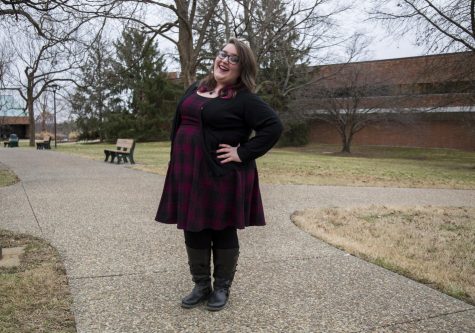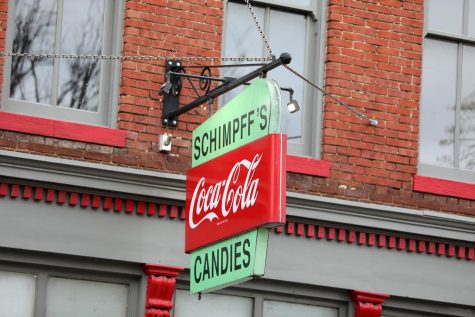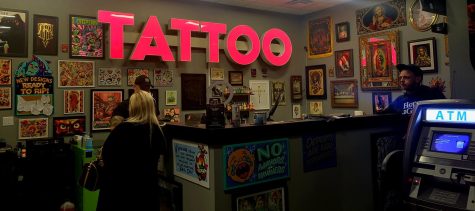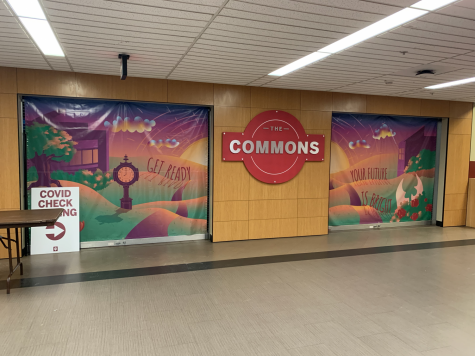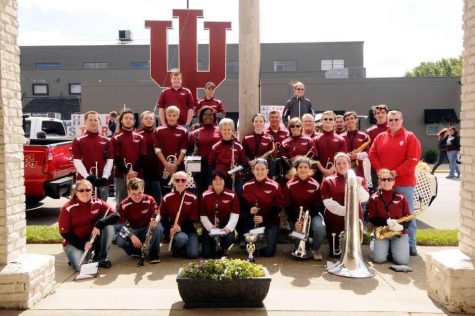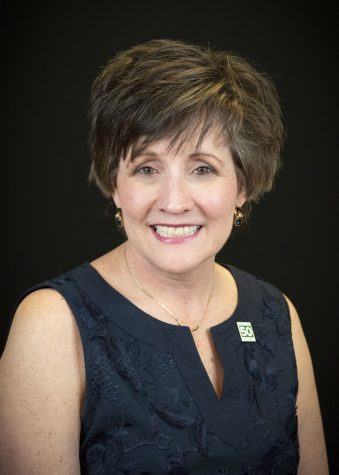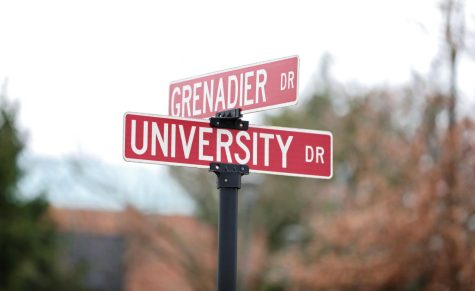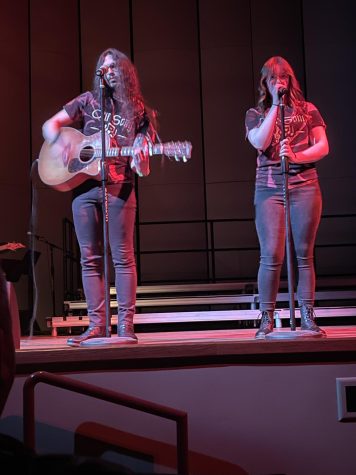Haunted Places of Kentuckiana
October 31, 2016
Culbertson Mansion
Tis the season. Not for Santa and his elves but for ghost, monsters and supernatural happenings of all kinds.
Halloween is the one time of the year when some people don’t mind being scared out of their minds in a deep and primal way.
Over the last 37 years, The Culbertson Mansion has put on a haunted house attraction called; Literally, A Haunted House at The Culbertson Mansion. Every year it has a different theme, from deranged dentists to classic monsters. 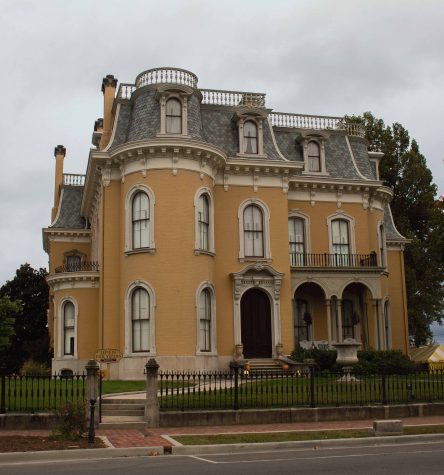
This year, over 100 volunteers and staff will be on hand to prey upon your deepest phobias. Admission is $14.
Site manager Jessica Stavros has experienced a lot of interesting happenings while working in the mansion.
Stavros said the mansion has a few other fund raising events throughout the year put on by a group of local volunteers called the Friends of Culbertson Mansion. They host several murder-mystery style parties which recreate the William Culbertson funeral.
She said a life-sized coffin with a fully recreated life-like William Culbertson lies within it. His widow is at the head of the open coffin crying over the loss of her husband. A guest at the funeral dies under suspicious circumstances. Who did it? The guests play detectives to try and solve the murder at the funeral.
The Friends of Culbertson Mansion also sponsor events like Victorian afternoon teas, Victorian style dance balls, a ghostly happenings tour and a ghost watch sleepover.
Outside of the annual happenings there are those that say they have had experiences in the house.
“I heard footsteps start in the front window bay of the formal parlor and walk across the floor,” said Erin Jackson, a former employee of the mansion. “The footsteps stopped directly above my desk and didn’t make any further sound.”
“All the doors were locked, and the alarm system would beep anytime an exterior door was opened so I knew no one had come in from outside. The footsteps sounded like a wooden heeled shoe.”
After Jackson checked all the exterior doors and windows, she said she then checked to see if anyone was hiding in the house. There wasn’t anyone there.
During the extended tour of the mansion there was a light fixture that had only one light flicker off then back on in a hallway.
Site manager Stavros said it wasn’t the first time that had happened and she blamed it on a bad fixture.
One mainstay character of the haunted house is Dr. Webb. Stavros said the lore goes like this: After a period of inactivity at the house, investigators from the local police found the place abandoned and Dr. Webb’s family members violently murdered in every room. In the basement they found Dr. Webb’s torture chambers where he had perpetrated unspeakable experiments on his patients. 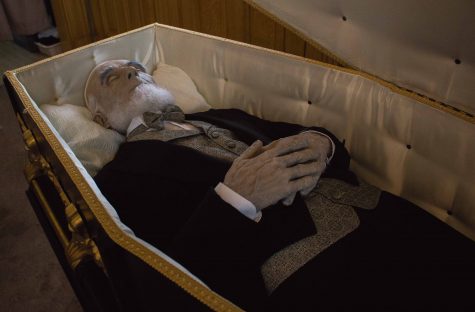
“Clanging sounds, unpleasant smells and a dark man’s apparition were repeated occurrences in the 1900s when the Webb family and Dr. Webb’s office occupied the building”, said Stavros.
Stavros said the story of Dr. Webb was made up for one of the mansion’s Halloween events and has taken on a life of its own and is now an urban legend.
Once the supernatural veil is lifted there is much more going on at The Culbertson Mansion than an annual haunting.
Stavros said the house is also a museum with an extensive restoration project happening.
She said all of the approximate $30,000 raised every year during the haunted house event goes back into the house to pay for its restoration. Through its haunting efforts the mansion’s staff have raised about $700,000 over the years, according to their website. hauntedculbertson.org.
According to the Indiana State Museum and Historic Sites, the Culbertson Mansion is one of 12 official state historic sites run by the state of Indiana.
Stavros said the museum is another avenue of money for the home’s restoration. There is a charge of $10 per adult for a guided tour of the preserved Victorian home.
She said the restoration process has been going since 1964 and will continue on for several more to come.
Along with the restoration, there is always a search for appropriate Victorian pieces to display.
Kristina Kimmick, the program director, said while all the furniture is original to the time period, none of the furniture is original to the house. She said this is because in May 1899 there was an auction of all the contents of the house.
“No records of the sales were kept, so it is impossible to track down any of the sold items” said Kimmick.
She said because there were so few records kept by Culbertson, no one knew what the inside of the mansion looked like.
Kimmick said some of the furniture and displays were set up by guess work. The staff used furniture layouts that were normal to the period to set up the various rooms. It wasn’t until a document the staff refer to as “The Article,” did they realize how the house was laid out.
In July 1869, a reporter from the Daily Commercial, who’s name is lost to history, came to the house to do a story titled “The Splendid Residence of W.S. Culbertson Esq. — The Finest House in the State –A Description of the Building, Its Furniture, &c.”
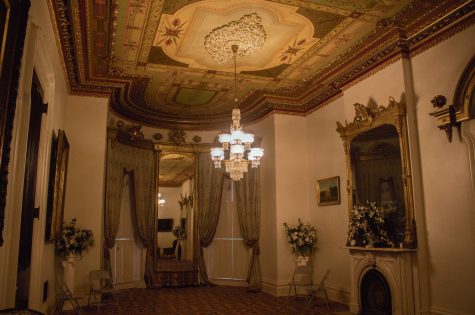 Kimmick said in the story were room dimensions, paint schemes and the home’s decor all documented in great detail. After surfacing, this document was used by the staff and became know as “The Article.”
Kimmick said in the story were room dimensions, paint schemes and the home’s decor all documented in great detail. After surfacing, this document was used by the staff and became know as “The Article.”
“Culbertson occupied the home from 1867, when it was built, till his death in 1893. His third wife Rebecca occupied the home until 1899”, said Stavros.
Stavros said it was a part of Culbertson’s will that, once Rebecca left, the home would pass on to his children. But his children were building their own homes and had no need for the mansion they were born in.
According to the Culbertson Mansion State Historic Site booklet, the mansion was sold at auction to John S. McDonald.
Stavros said McDonald had a small family consisting of only himself, his wife Mary and his two children Helen and Morris. Due to the fact there were only four of them and the cost of heating such a large house was high, McDonald boarded up parts of the house to save money.
The Historic Site booklet said in 1946, after her parents passing, Helen sold the home to the American Legion.
It was in 1976, after several years of struggling to maintain the home, it was gifted to the State of Indiana to be run as a historic site. The home is now run by The Indiana Department of Natural Resources, which makes an effort to restore the home to its original condition.
The Historic Site booklet said the DNR removed the addition the American Legion added on to the house. They reconstructed the first floor verandah and converted the servants’ wing on the third floor into an apartment for the on-site curator. Also, the DNR performed a restoration of the exterior by working on the chimneys, cornices and cast-iron ornamentation. Over the years the home was completely rewired and fire and security systems were installed. The roof was replaced, HVAC was installed and the curator was no longer required to live at the house.
Today, while many parts of the house with its bright pinks and beiges that seemed to change with the movement of the sun and Victorian period furniture are on display,there is still active restoration happening every day.
Stavros would like the restorations be completed within her lifetime, but she
“Doesn’t think that will be likely happening,” Stavros added.
As far as regarding the paranormal activity, Stavros has a unique attitude about them.
“A haunting is literally bringing history to life.”
Louisville Palace
Just across the river, Theater Square in Downtown Louisville is a reminder of the past. The marquis of the Louisville Palace stands tall and proud, a constant reminder to all who pass that Louisville’s bygone days were ornate. The Louisville Palace is a place with a rich history.
It is also a place with a lesser-known haunted history.
The haunted history of the Louisville Palace dates back to the 1920s; back to the days when theaters lined the Downtown area and people crowded the streets to see the latest flick. Those days are long gone, replaced now with a supernatural presence that inhabits the Palace. 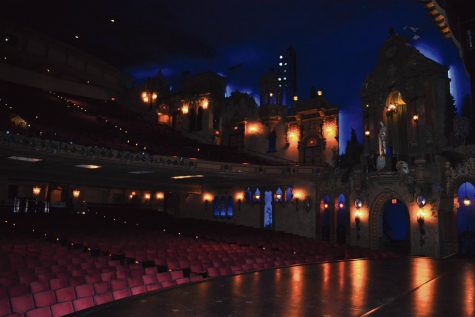
For those wishing to get a glimpse into the haunted history, a guided tour is offered for those brave enough to take it.
Mallory Kramer is the marketing manager and talent booker for the Louisville Palace and Mercury Ballroom. When she is not busily booking talent like Macklemore and Lindsey Stirling to perform on stage at the Palace, she is the resident tour guide, giving the haunted history tours around Halloween each year.
Kramer’s tour tells a tale of Louisville Palace and its haunted history that goes back to a time before it was even known as the Palace.
“The grand opening was September 1, 1928. It was known as Loew’s Theater,” Kramer said. “In the 1920s, the entire block known as Theater Square was filled with theaters for the wealthy. This was also the time when going to the movies became popular.
The theater was originally built for movies, although it did sometimes have live performances.
These were the days when going to the theater was a production in and of itself.
“It was a day out at the theater,” Kramer said. “Women wearing gloves and hats, everyone getting really done up. It wasn’t a quick thing like it is now. So much emotion and time and energy filled the place. This is why we think it’s haunted.”
Stepping through the front doors into the lobby, visitors are met with elaborately designed carvings from floor to ceiling. The staircase on the right takes your eyes up, leading you to original statues and more intricate designs.
The entire Palace is done in a Spanish Baroque style. All of the intricate work is done in stucco plaster. There is enormous attention to detail, from the gargoyles to the smallest fleur de leis.
“I’m sure you’ve heard of the Gray Lady,” Kramer said as she led the way up the staircase.
The Gray Lady, sometimes thought of as a widow with a lost love, is a lonely apparition that is said to haunt the hallways of the Louisville Palace. She is most often seen going up the steps of the first staircase and continuing down the hallway.
“Some of the staff have seen her walking across the hallway,” Kramer said. “Most of the time she doesn’t look at anything. She wears period clothing and sometimes she has a playbill in her hands. She seems to be going through the entire theater, trying to find her lost love.”
Further down the hallway, Kramer stopped at a hanging sign reading “Gentlemen’s Lounge.” The illuminated sign sits outside what is now a men’s restroom. Stepping inside, one will see carvings on the moldings near the ceiling depicting old men with smoking pipes hanging out of their mouths.
“The Gentlemen’s Lounge was a congregational smoking area. A community area,” Kramer said. “From time to time, we still smell cigar smoke for no reason during the day; not during or after a show, but usually when no one else is around.”
Kramer said the phantom smell has wafted through the halls of the Palace on more than one occasion, sometimes even bothering performers on the first floor in the Faces Lobby, which sits across and down from the lounge.
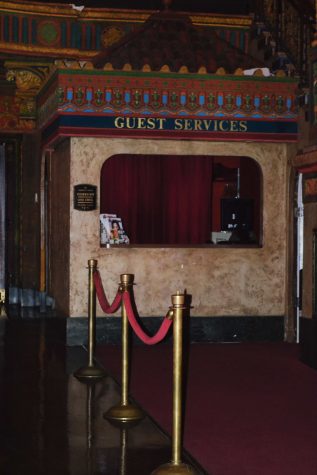 “The Faces Lobby was made to enable visitors to see the length and grandeur of the Palace,” Kramer said. “Once, at a meet and greet in that lobby, a Broadway actress stopped what she was doing and said ‘someone is smoking; stop smoking, it’s upsetting my voice!’ We told her that this happens from time to time; that she was smelling a supernatural presence.”
“The Faces Lobby was made to enable visitors to see the length and grandeur of the Palace,” Kramer said. “Once, at a meet and greet in that lobby, a Broadway actress stopped what she was doing and said ‘someone is smoking; stop smoking, it’s upsetting my voice!’ We told her that this happens from time to time; that she was smelling a supernatural presence.”
Just across the hall from the Gentlemen’s Lounge is a newer lounge and bar area. This lounge area is not original to the Palace. It was added on as the Palace became more of a live concert venue.
From time to time, people have heard walking in this lounge when the Palace is closed.
Kramer spoke about an incident that the theater’s production manager experienced one night while walking downstairs.
“He heard stomping up here,” she said. “He came through and walked around, but couldn’t find a thing,”
Then, he heard more footsteps.
“As he was turning around to inspect some more, he was shoved and heard children laughing,” Kramer said. “The reason, we imagine, is that this entire block used to be a children’s hospital, before the theater block. Long before the 1920s. We think that some children are still lingering.”
From the lounge area, Kramer led the way down multiple flights of stairs to what is now the production office space and vending area. The space also houses where musical acts and production crews eat.
“This whole room used to be the entire maintenance area,” Kramer said. “It was filled with pipes. ”
Ferdinand Frisch was the main maintenance man for the Palace in the 1960s. In 1967, he died suddenly of a heart attack inside the Palace.
“He has been the only death at the Palace,” she said. “We call him Fred. He was found the morning after he passed by the house manager. He still watches over the entire Palace.”
Kramer said she has never personally experienced any happenings involving Fred, but that other employees have.
The director of operations once had an instance where lights were continually flickering. It became annoying to him when it wouldn’t stop.
He went to investigate.
“There’s only one breaker box for the entire theater,” Kramer said. “Near the box, there was a pipe that had just burst. Had the lights not been flickering, and had he not gone checked, the pipe would have flooded the whole theater. Had Fred not come to him, it would have flooded.”
Kramer said there are always happenings around the Palace, and the employees chalk it up to Fred helping out.
“Little things all the time. Also any time something major happens, Fred has a way to let everyone know,” she said.
Kramer headed up two flights of stairs into the dressing room area. Nothing supernatural has happened in that area, but Kramer said the thought of who has graced the rooms in the past lingers; that imaging all of the artists that passed on recently that once performed there.
She led the way into an unassuming room with mirrors and curtains.
“This was Prince’s dressing room when he performed here. It’s sort of unremarkable, but to think that he just recently passed away and performed here,” Kramer said. “It is really heartwarming to think that he could revisit the places he performed; to think that the past acts we’ve had could revisit.”
Just outside the hallway of dressing rooms was the door leading onto the stage and theater area. The ghost light sat in the middle front of the stage.
The ghost light is a theater tradition, with employees leaving it on 24/7 to allow it to light the way for actors and musicians to come through.
Only a few supernatural occurrences have been reported to have happened inside the actual theater.
When work was started to restore the Palace, the ceiling work was also started at that time. A worker was on scaffolding up on the ceiling in the very top by the catwalk, tied in. 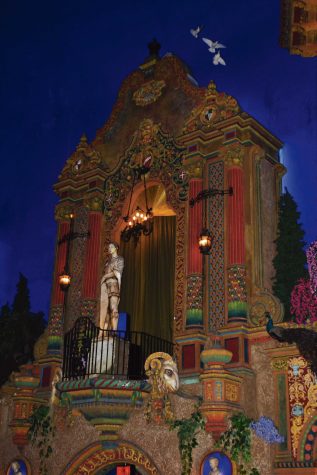
“He was taking a nap,” Kramer said. “He felt someone pushing him saying ‘wake up! Wake up!’. He woke up and realized that he was about to roll off the side of the scaffolding,” she said. “We believe that was another time that Fred stepped in to help the workers. We believe he really oversees and assists us all here at the Palace.”
Two other occasions were remarkable enough to be reported from inside the theater.
“We’ve had production crew and people on the stage spot The Gray Lady walking down the very first isle in the theater,” she said. “We also had a woman on our production crew that saw a large, dark, black animal running up an aisle. We associate that with the stories of the black dog representing death and bad fortune.”
As Kramer led the way back out to the main lobby, she said that most of the supernatural activity experienced by crew members and Palace staff happen during a specific time.
“Most supernatural activity here seems to take place during restoration periods,” she said. “Disturbing the past seems to bring them out, which is typical of supernatural activity. The energy builds up. So as we are doing these changes, that’s when the activity occurs.”
Kramer said that as the Palace continues to be changed and restored, they will continue to see and experience supernatural activity.
Kramer closed the tour with a smile, adding that she wanted to point out that the activity does not just occur during the nighttime hours. There are occurrences during the day, when the production team is working odd hours.
“They really experience things all the time,” she said.
The Gray Lady has been seen in broad daylight by not just staff, but also by people getting ready for shows.
The children in the lounge have only been heard at night, though.
“More activity seems to happens at night,” Kramer said. “More seems to happen when everything around here is more silent.”

